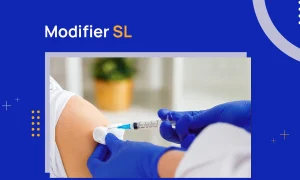Do you believe that only the performance of the spinal decompressions is complex? Think again! Because billing for these surgical procedures is equally intricate.
Failure to establish medical necessity, fulfill documentation requirements, adhere to bundling rules, and append the appropriate modifier are a few challenges to name. Even a slight error in a patient’s demographic records is enough to trigger denial, resulting in a strained revenue cycle.
If you do not have an in-house billing specialist or certified professional coder (CPC) to navigate through these complicated requirements, this guide is for you!
It will equip you with the necessary knowledge to bill CPT code 63047 accurately.
So, are you ready to get started?
What is CPT Code 63047?
Are you tired of leaving money on the table due to coding inaccuracies? You can change all that, but first, you need to understand the descriptor.
So, here we go!
CPT code 63047 covers laminectomy, facetectomy, and foraminotomy at a single lumbar vertebral segment to correct spinal stenosis. During it, the surgeon also decompresses the spinal cord or nerve roots.
Here is what each of the three components of this procedural code entails:
- Laminectomy – It includes excision of the thin bony plate at the back of a vertebra.
- Facetectomy – It involves the excision of an area of a vertebra characterized by its smooth surface.
- Foraminotomy – It includes incision into the vertebral opening through which nerve bundles exit to the body.
Note: The procedure covered under CPT 63047 can either be unilateral or bilateral.
Scenarios Where CPT Code 63047 is Applicable
Now that we have explained the descriptor, it is time to look into some real-world clinical scenarios related to CPT code 63047:
Bilateral Lumbar Spinal Stenosis
Do you know that over 200,000 adults are affected by lumbar spinal stenosis (LSS) in the US? It is a spinal disorder primarily in the older population. People with LSS often experience pain in the lower extremity or buttock with or without back pain. Physicians confirm it by ordering imaging studies (MRI or CT). The images for such patients visualize narrowing of spaces around neural and vascular elements in the lumbar spine.
Picture a 72-year-old female patient who comes to the clinic. She complains of experiencing progressive bilateral leg weakness, numbness, and cramping pain (neurogenic claudication). She further adds that the symptoms worsen when she walks.
For context, neurogenic claudication is the most common symptom of LSS.
The physical examination indicates a bilateral lower extremity sensory deficit. The physician orders an MRI to support this diagnosis. The images confirm lumbar spinal stenosis at the L3-L4 level.
Therefore, the neurosurgeon performs a bilateral laminectomy with facetectomy and foraminotomy (CPT code 63047). The L3-L4 decompressive laminectomy helps relieve pressure on the spinal cord and existing nerve roots.
Lumbar Spondylolisthesis Causing Central Stenosis
Before we discuss another clinical scenario, let’s further understand the prevalence of LSS. Research studies have found that 1 in 1,000 individuals over the age of 64 years and approximately 5 in 1,000 people over the age of 50 years likely suffer from LSS.
Imagine a 56-year-old male patient with known Grade I degenerative lumbar spondylolisthesis at L4-L5 visits the neurosurgeon. He complains of developing an increasing lower back pain and symptoms of central spinal stenosis, such as bilateral leg weakness and numbness. Initially, the physician attempts to relieve the symptoms through conservative treatment, but to no avail.
As a result, the neurosurgeon decides to go with a decompressive laminectomy at L4-L5 (CPT code 63047). During the procedure, the surgeon performs necessary facetectomies to relieve the central canal stenosis and decompress the nerve roots at that single lumbar segment.
Post-Laminectomy Syndrome with Recurrent Foraminal Stenosis
It is time to start with another clinical scenario, but before we do so, you must understand why the procedure covered under CPT code 63047 is integral. The demand to perform this procedure will increase. Why? According to a report, the prevalence of LSS is expected to grow to around 18,000,000 in the next decade.
With that said, consider a 55-year-old female patient who previously underwent a lumbar laminectomy at L4-L5 almost six years ago. She visits the neurosurgeon and reports the onset of severe right leg pain and weakness.
The neurosurgeon orders an MRI study, and it confirms recurrent foraminal stenosis at the same L4-L5 level. Besides, the images reveal that the foraminal stenosis is affecting the right L4 nerve root, likely due to scar tissue and recurrent facet hypertrophy.
As a result, the neurosurgeon performs a targeted L4-L5 left foraminotomy and minimal re-laminectomy to decompress the compromised nerve root.
Here, CPT code 63047 applies.
Note: The stats we shared throughout this section are enough to understand why accurately billing for CPT 63047 is integral for your practice’s revenue health.
Applicable Modifiers for CPT Code 63047
The following are all applicable modifiers for
Modifier 59 or XS
As per the National Correct Coding Initiative (NCCI) edits, you cannot bill CPT code 63047 with CPT codes 22630 or 22633 when performed at the same interspace. However, you are eligible for a separate reimbursement if the provider renders both services at different interspaces. But there’s a catch: you must append modifier 59 or XS to CPT 63047.
For the unversed, an interspace is a space between two adjacent vertebrae in the spine. You can also think of it as a specific vertebral level (L4-L5, etc.).
For clarity, here’s what CPT codes 22630 and 22633 involve:
- 22630 – It covers a posterior lumbar interbody arthrodesis (fusion).
- 22633 – It includes a posterior lumbar interbody fusion and a posterolateral fusion.
Modifier 57
As per the CMS coding guidelines, laminectomy with facetectomy and foraminotomy (CPT code 63047) is a major surgical procedure because it has a global period of 90 days.
Therefore, CPT 63047 includes all preoperative and postoperative evaluation and management (E/M) services in its reimbursement.
But what happens when an E/M service is conducted on the same day as the date of service of CPT 63047 to decide whether to perform this surgical procedure or not? You append modifier 57 to the E/M service code. This modifier indicates ‘decision for surgery’.
Modifier 52
CPT code 63047 covers three elements: (1) laminectomy, (2) facetectomy, and (3) foraminotomy.
Now, assume a scenario where the neurosurgeon initially decided to perform the complete procedure covered under CPT 63047. However, during the surgery, the surgeon determines that they have achieved adequate nerve root decompression with targeted laminectomy and foraminotomy. As a result, they do not need to perform extensive facetectomy.
Thus, you will report CPT 63047 with modifier 52 to indicate reduced service at the surgeon’s discretion.
Modifier 62
Let’s say a patient’s condition necessitates a need to perform both lumbar spinal decompression and fusion. Therefore, two neurosurgeons agreed to handle the case.
Surgeon A performs the decompression (CPT code 63047), while Surgeon B completes the spinal fusion with instrumentation. Note that these surgeons were present in the operating room at the same time.
It is a clear example of co-surgery (involvement of two surgeons), in which each surgeon independently performs their portion of the surgery. Thus, both surgeons should report their relevant procedural codes with modifier 62.
Modifier AS, 80 & 81
Complex surgical procedures often demand the involvement of an assistant surgeon. These three modifiers are integral to the reporting services of assistant surgeons.
Let’s take the same scenario we discussed for modifier 62. We discussed co-surgery, but there’s more to it. Due to the complexity of both procedures, an assistant surgeon was present, assisting both surgeons.
Now the assisting provider will report CPT code 63047 and relevant fusion codes with any of the modifiers to ensure rightful reimbursements:
- AS – It indicates that a physician assistant (PA), nurse practitioner (NP), or clinical nurse specialist (CNS) assisted at surgery.
- 80 – It highlights the services of an assistant surgeon at surgery.
- 81 – It means that the assistant surgeon’s services were minimal at surgery.
Note: Only Medicare recognizes modifier AS.
CPT Code 63047 Billing & Reimbursement Guidelines
Discussed below are the fundamental billing and reimbursement guidelines for CPT code 63047:
Demonstrate Medical Necessity
Believe it or not, but no payer (federal or commercial) will reimburse for services that are not medically necessary. Therefore, you must strive to support the medical necessity of the procedure in your documentation. Thus, ensure to include:
- Document patient symptoms like neurogenic claudication, weakness, radicular numbness, pain, or other neurological deficits.
- Include the findings of the physical examination focusing on sensation, motor strength, reflexes, special tests, and gait.
- Attach images and report of the diagnostic imaging study (CT or MRI) that confirmed the diagnosis.
You should also mention why you are moving towards a surgical approach (CPT code 63047). Most payers want providers to first try conservative treatments for LSS (e.g., medication, injections, physical therapy, or activity modification) for a specified period.
Thus, clearly state a trial of non-surgical conservative treatment that failed to relieve the patient’s symptoms. However, payers may make exceptions for some progressive neurological deficits.
Focus on Detailed Documentation
Ensuring comprehensive documentation is another essential guideline for billing CPT code 63047. Therefore, your operative report must include:
- The specific lumbar vertebral segment where the surgeon performed the procedure (e.g., L4-L5).
- State whether the surgeon performed the procedure on one side or both sides (unilateral or bilateral).
- Mention the elements the surgeon worked on, e.g., partial laminectomy, medial facetectomy, foraminotomy.
- Explain the reason for performing the surgery.
- Confirm that the surgeon successfully decompressed the neural elements.
Review Payer-Specific Policies
Billing and reimbursement guidelines related to CPT code 63047 significantly vary for federal programs and other private payers. Therefore, establish open lines of communication with the payer, stay current on the policy updates, and ensure adherence to the specific coding and documentation requirements.
Final Thoughts on CPT Code 63047
Throughout this guide, we have discussed how integral it is for neurosurgeons to capture CPT code 63045 to ensure a positive financial performance. We have looked at the prevalence of LSS. Besides, we shared applicable modifiers and essential reimbursement guidelines. However, we understand that despite going through this comprehensive guide, you still struggle with reporting this surgical procedure. But the good news is, you can outsource neurology billing services to professionals at NeuraBill for affordable rates. So, what are you waiting for? Schedule a free billing audit and get started!



